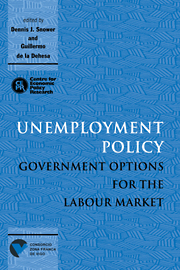Book contents
- Frontmatter
- Contents
- List of figures
- List of tables
- Preface
- Acknowledgements
- List of conference participants
- 1 Introduction
- PART ONE GENERAL POLICY ISSUES
- PART TWO DEMAND MANAGEMENT AND SUPPLY-SIDE POLICY
- PART THREE SUBSIDISING EMPLOYMENT AND TRAINING
- 6 The simple economics of benefit transfers
- Discussion
- Discussion
- 7 Wage subsidy programmes: alternative designs
- Discussion
- Discussion
- 8 Technological development, competition from low-wage economies and low-skilled unemployment
- Discussion
- 9 Macroeconomic and policy implications of shifts in the relative demand for skills
- Discussion
- 10 Would cutting payroll taxes on the unskilled have a significant impact on unemployment?
- Discussion
- 11 Preventing long-term unemployment: an economic analysis
- Discussion
- Discussion
- PART FOUR LABOUR MARKET REGULATIONS
- PART FIVE POLICY, JOB REALLOCATION AND THE UNEMPLOYMENT–PRODUCTIVITY RELATION
- PART SIX COMPARING UNEMPLOYMENT POLICIES
- Index
Discussion
Published online by Cambridge University Press: 07 September 2010
- Frontmatter
- Contents
- List of figures
- List of tables
- Preface
- Acknowledgements
- List of conference participants
- 1 Introduction
- PART ONE GENERAL POLICY ISSUES
- PART TWO DEMAND MANAGEMENT AND SUPPLY-SIDE POLICY
- PART THREE SUBSIDISING EMPLOYMENT AND TRAINING
- 6 The simple economics of benefit transfers
- Discussion
- Discussion
- 7 Wage subsidy programmes: alternative designs
- Discussion
- Discussion
- 8 Technological development, competition from low-wage economies and low-skilled unemployment
- Discussion
- 9 Macroeconomic and policy implications of shifts in the relative demand for skills
- Discussion
- 10 Would cutting payroll taxes on the unskilled have a significant impact on unemployment?
- Discussion
- 11 Preventing long-term unemployment: an economic analysis
- Discussion
- Discussion
- PART FOUR LABOUR MARKET REGULATIONS
- PART FIVE POLICY, JOB REALLOCATION AND THE UNEMPLOYMENT–PRODUCTIVITY RELATION
- PART SIX COMPARING UNEMPLOYMENT POLICIES
- Index
Summary
Dennis Snower has written a very useful chapter, one that should be studied carefully by policy makers searching for practical measures to reduce high levels of unemployment. The chapter presents a concrete proposal that takes seriously the problem of policy design. The proposed Benefit Transfer Programme (BTP) is voluntary and relatively simple. The programme aims to reduce long-duration unemployment by allowing individuals who have been unemployed for a minimum period of time to convert their unemployment insurance benefits into either recruitment or training vouchers. In this way, it would remove disincentives to job search in unemployment insurance schemes and replace them with incentives for hiring and training. Moreover, the programme is designed to be neutral with respect to government expenditures; and to the extent that the programme reduces unemployment and thereby enlarges the tax base, it will increase government revenues. These are all attractive features that suggest that the programme would be political viable.
Although I see no fundamental problems with the proposed programme, there are a number of issues that could be usefully clarified. It is not clear, for example, how one ensures that the total cost of the voucher scheme is the same as the cost of benefits it replaces. This is because the voucher is not linked to the individual's actual unemployment benefits, the value of which is readily calculated, but rather to benefits broadly interpreted ‘to include forgone taxes and the full spectrum of welfare state benefits falling on the unemployed’, which are difficult if not impossible to calculate ex ante.
- Type
- Chapter
- Information
- Unemployment PolicyGovernment Options for the Labour Market, pp. 199 - 202Publisher: Cambridge University PressPrint publication year: 1997



